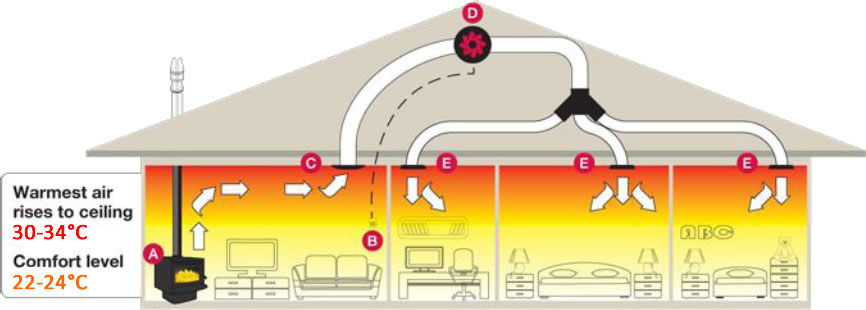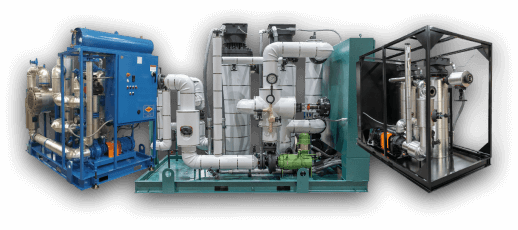Live Data Feedback: How DVS Heat Transfer Systems Enable Predictive Maintenance
A Comprehensive Overview to Picking the Right Heat Transfer Solutions for Your Requirements
Choosing the suitable Heat transfer system is vital for operational performance. Various systems deal with different demands, influenced by aspects such as temperature level array and liquid type. Understanding the principles behind Heat transfer, such as convection, radiation, and transmission, is critical. Furthermore, reviewing energy sources and maintenance techniques can impact long-term performance. A closer examination of these factors to consider discloses how to customize a system to details needs. What should one prioritize in this complex decision-making procedure?
Recognizing Heat Transfer: Key Principles and Concepts
Although Heat transfer might appear like a straightforward concept, it incorporates a series of concepts that are essential for efficient system design. Understanding these principles is essential for designers and developers who aim to enhance thermal efficiency in various applications. Transmission, as an example, involves the transfer of Heat via strong materials, while convection refers to the activity of Heat within fluids. Radiation, one more crucial concept, defines exactly how Heat can be transferred via electro-magnetic waves. Each of these devices plays an essential duty in figuring out how power relocates within a system. By extensively understanding these ideas, experts can make enlightened choices, making certain that Heat transfer systems operate successfully and fulfill the certain demands of their applications
Kinds Of Heat Transfer Systems: A Summary
Understanding the concepts of Heat transfer prepares for discovering the various kinds of Heat transfer systems offered. Heat transfer systems can be categorized mainly right into three types: conduction, convection, and radiation. Transmission entails Heat transfer via strong materials, counting on direct contact between particles. Convection, on the various other hand, occurs in liquids (gases and fluids) where the activity of the fluid itself assists in Heat transfer. Radiation involves the transfer of Heat with electro-magnetic waves and does not need a medium, allowing it to take place in a vacuum. Each kind of system has distinct qualities and applications, making it essential for individuals and organizations to meticulously assess their particular needs when choosing the most appropriate Heat transfer solution.
Applications of Heat Transfer Equipments in Different Industries
Heat transfer systems play a crucial function across numerous markets, impacting performance and item quality. In industrial manufacturing processes, they facilitate precise temperature level control, while in food and drink processing, they assure safety and security and conservation. Additionally, HVAC and environment control systems depend heavily on efficient Heat transfer to keep comfortable atmospheres.
Industrial Manufacturing Processes

Countless commercial production procedures rely greatly on reliable Heat transfer systems to make the most of efficiency and improve product high quality. In industries such as metalworking, Heat exchangers play a necessary function in preserving ideal temperature levels during welding, spreading, and creating. These systems assure uniform Heat circulation, which is important for accomplishing desired product properties. In a similar way, in the chemical manufacturing sector, Heat transfer systems facilitate exact temperature control throughout reactions, impacting yield and safety and security. In textile manufacturing, reliable Heat monitoring is crucial for dyeing and ending up processes, influencing shade consistency and fabric quality. By choosing appropriate Heat transfer modern technologies, suppliers can improve power performance and reduce operational costs, eventually causing a more affordable and lasting production environment.
Food and Beverage Processing
Efficient Heat transfer systems are similarly important in the food and drink handling market, where preserving ideal temperatures is critical for food security and top quality. These systems play a necessary duty in procedures such as sanitation, pasteurization, and cooking, making certain that items are safe for intake and preserve their nutritional value. Heat exchangers, for example, efficiently move Heat between fluids, optimizing energy usage while decreasing temperature level variations. Additionally, refrigeration systems are fundamental for protecting perishable things and prolonging life span. The selection of Heat transfer innovation directly affects operational performance and product honesty, making it vital for food and drink manufacturers to pick the appropriate systems customized to their details handling demands. This careful choice eventually adds to customer fulfillment and food safety and security.

Heating And Cooling and Climate Control
While numerous markets depend on Heat transfer systems for performance, COOLING AND HEATING (Heating, Ventilation, and Air Conditioning) plays an important role in preserving indoor environment control across different setups. These systems use Heat transfer principles to regulate air, humidity, and temperature level top quality, making certain comfort and safety and security in property, business, and industrial environments. Correctly developed cooling and heating systems enhance energy effectiveness, decrease operational expenses, and lessen ecological impact. In industrial structures, for example, efficient environment control adds to staff member productivity and consumer contentment. In commercial applications, HVAC systems help keep perfect problems for tools operation and item preservation. Selecting the best Heat transfer system is vital for conference specific environment control demands click for info and attaining general system efficiency.
Examining Energy Resources for Heat Transfer Systems
In reviewing energy sources for Heat transfer systems, a comparison of renewable resource choices and fossil gas considerations is crucial. Sustainable sources, such as solar and wind, deal sustainable options that can lower ecological influence. Conversely, nonrenewable fuel sources stay common due to their well established infrastructure and power density, triggering a careful analysis of both alternatives.
Renewable Energy Options

Fossil Fuel Factors To Consider
Reviewing fossil fuel considerations is essential for the efficiency and sustainability of Heat transfer systems. Fossil gas, such as all-natural gas, oil, and coal, are standard energy resources that offer significant Heat result, making them popular choices for commercial and domestic applications. Nonetheless, their ecological effect, including greenhouse gas exhausts and source exhaustion, elevates problems. When picking a heat transfer system, it is vital to analyze the schedule, cost, and regulative elements related to these fuels. Furthermore, the effectiveness of fossil gas systems should be considered, as higher effectiveness can minimize some ecological drawbacks. Ultimately, a well balanced technique weighing performance and sustainability can guide decision-makers toward the most ideal Heat transfer option for their certain needs.
Elements to Take Into Consideration When Selecting a Heat Transfer System
Selecting an appropriate Heat transfer system calls for careful consideration of numerous factors that can significantly impact performance and efficiency. One essential factor is the operating temperature level array, which dictates the materials and style appropriate for the application. In addition, the sort of liquid used in the system-- whether gas or liquid-- influences Heat transfer efficiency and compatibility. The system's size and ability must line up with the details demands of the operation to stay clear of inefficiencies. Power resource availability is additionally necessary, influencing operating expense and sustainability. Furthermore, the installation environment, including space restrictions and ease of access for upkeep, plays a considerable function in system choice. Regulatory conformity and safety requirements must be taken into consideration to assure the system satisfies all legal needs.
Maintenance and Performance Optimization for Heat Transfer Equipments
Preserving Heat transfer systems is essential for ensuring optimal efficiency and durability. Normal maintenance activities, such as cleaning up Heat exchangers and inspecting insulation, aid protect against performance losses as a result of fouling and thermal linking. In addition, keeping an eye on system criteria, including stress and temperature, enables early discovery of abnormalities, lessening downtime and pricey repair work. Carrying out a preventive maintenance routine can enhance performance and extend the life expectancy of components. Additionally, updating to innovative control systems can boost operational effectiveness by readjusting to differing conditions and lots. By prioritizing maintenance and effectiveness optimization, drivers can attain lowered energy consumption, lower functional costs, and improved total system reliability, eventually bring about better look at this site resource use and an extra lasting procedure.
Future Patterns in Heat Transfer Technologies
As industries significantly focus on sustainability and power effectiveness, future trends in Heat transfer modern technologies are readied to undertake significant changes. Innovations such as sophisticated materials, consisting of carbon nanotubes and nanofluids, assure improved thermal conductivity and efficiency. Additionally, the integration of renewable power sources right into Heat transfer systems is gaining momentum, promoting environmentally friendly options. Smart technologies, including IoT sensors, are expected to reinvent tracking and control, making it possible for real-time information evaluation for optimized performance. Furthermore, the development of portable and modular systems will assist in easier installation and upkeep, satisfying diverse applications. These innovations suggest a change towards even more sustainable, reliable, and adaptable Heat transfer services, straightening with international energy objectives and environmental criteria.
Regularly Asked Questions
What Are the Environmental Effects of Heat Transfer Equipments?
The environmental effects of Heat transfer systems can consist of greenhouse gas emissions, power consumption, and prospective thermal pollution. In addition, improper disposal of inadequacies and materials can add to resource deficiency and environment disturbance.
How Do I Determine the Cost-Effectiveness of a Warmth Transfer System?
To calculate the cost-effectiveness of a warm transfer system, one have to examine first costs, operational costs, upkeep requirements, and power performance, comparing these aspects against the expected life-span and efficiency of the system.
Can Heat Transfer Systems Be Utilized in Residential Setups?
Heat transfer systems can without a doubt be made use of in property settings. They supply effective home heating and cooling down options, making homes more comfortable while potentially lowering power expenses. Their convenience allows for different applications in property atmospheres.
What Security Rules Apply to Heat Transfer Systems?
Safety and security guidelines for Heat transfer systems usually consist of standards on upkeep, procedure, and installment. Conformity with local building ordinance, manufacturer specs, and market requirements is necessary to guarantee reliable and secure system efficiency in numerous applications.
How Do Various Materials Affect Heat Transfer Effectiveness?

Conduction, for instance, involves the transfer of Heat via strong products, while convection refers to the movement of Heat within liquids. Understanding the principles of Heat transfer lays the foundation for discovering the various kinds of Heat transfer systems offered. Heat exchangers, for circumstances, efficiently move Heat in between fluids, enhancing power use while lessening temperature fluctuations. In assessing energy sources for Heat transfer systems, a comparison of eco-friendly power options and fossil fuel considerations is vital. Metals, such as copper and light weight aluminum, conduct Heat efficiently, whereas insulators like rubber and glass slow down Heat circulation.